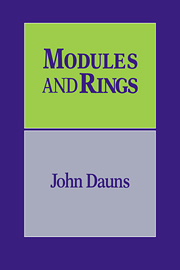Book contents
- Frontmatter
- Contents
- PREFACE
- NOTE TO THE READER
- CHAPTER 1 MODULES
- CHAPTER 2 FREE MODULES
- CHAPTER 3 INJECTIVE MODULES
- CHAPTER 4 TENSOR PRODUCTS
- CHAPTER 5 CERTAIN IMPORTANT ALGEBRAS
- CHAPTER 6 SIMPLE MODULES AND PRIMITIVE RINGS
- CHAPTER 7 THE JACOBSON RADICAL
- CHAPTER 8 SUBDIRECT PRODUCT DECOMPOSITIONS
- CHAPTER 9 PRIMES AND SEMIPRIMES
- CHAPTER 10 PROJECTIVE MODULES AND MORE ON WEDDERBURN THEOREMS
- CHAPTER 11 DIRECT SUM DECOMPOSITIONS
- CHAPTER 12 SIMPLE ALGEBRAS
- CHAPTER 13 HEREDITARY RINGS, FREE AND PROJECTIVE MODULES
- CHAPTER 14 MODULE CONSTRUCTIONS
- CHAPTER 15 CATEGORIES AND FUNCTORS
- CHAPTER 16 MODULE CATEGORIES
- CHAPTER 17 FLAT MODULES
- CHAPTER 18 PURITY
- APPENDIX A BASICS
- APPENDIX B CERTAIN IMPORTANT ALGEBRAS
- LIST OF SYMBOLS AND NOTATION
- BIBLIOGRAPHY
- SUBJECT INDEX
- AUTHOR INDEX
CHAPTER 10 - PROJECTIVE MODULES AND MORE ON WEDDERBURN THEOREMS
Published online by Cambridge University Press: 20 October 2009
- Frontmatter
- Contents
- PREFACE
- NOTE TO THE READER
- CHAPTER 1 MODULES
- CHAPTER 2 FREE MODULES
- CHAPTER 3 INJECTIVE MODULES
- CHAPTER 4 TENSOR PRODUCTS
- CHAPTER 5 CERTAIN IMPORTANT ALGEBRAS
- CHAPTER 6 SIMPLE MODULES AND PRIMITIVE RINGS
- CHAPTER 7 THE JACOBSON RADICAL
- CHAPTER 8 SUBDIRECT PRODUCT DECOMPOSITIONS
- CHAPTER 9 PRIMES AND SEMIPRIMES
- CHAPTER 10 PROJECTIVE MODULES AND MORE ON WEDDERBURN THEOREMS
- CHAPTER 11 DIRECT SUM DECOMPOSITIONS
- CHAPTER 12 SIMPLE ALGEBRAS
- CHAPTER 13 HEREDITARY RINGS, FREE AND PROJECTIVE MODULES
- CHAPTER 14 MODULE CONSTRUCTIONS
- CHAPTER 15 CATEGORIES AND FUNCTORS
- CHAPTER 16 MODULE CATEGORIES
- CHAPTER 17 FLAT MODULES
- CHAPTER 18 PURITY
- APPENDIX A BASICS
- APPENDIX B CERTAIN IMPORTANT ALGEBRAS
- LIST OF SYMBOLS AND NOTATION
- BIBLIOGRAPHY
- SUBJECT INDEX
- AUTHOR INDEX
Summary
Introduction
At this point the reader might wish to refamiliarize her or himself with the basic Wedderburn theory, covered in 7–1.35 through 7–1.43. Since we first use projective modules in this chapter (in Theorem 10–4.4), they are discussed at the beginning of this chapter. The reader who is mainly interested in the refinements and additions to Wedderburn theory of this chapter, need only read 10–1.1 through 10–1.13. Since projective modules are important in their own right, and since we need them in many subsequent chapters, the rest of the elementary theory of projectives is also developed in the first section of this chapter.
Projective modules are generalizations of free modules, because a free module is projective. For this reason logically, in successively studying more and more general classes of modules, they could very well be studied right after the free modules and before the injectives. In our treatment of free, projective, and injective modules we are assuming the ring R has an identity 1 ≠ 0 and all modules are unital. However, from then on in sections 10–2 throughout 10–7, we most decidedly do not assume that the ring has an identity. This chapter can be looked upon as being an improvement and extension of previous more basic material – first, the projective modules generalize the free ones, and then we develop in more detail the fundamental Wedderburn theory already covered in 7–1.35 through 7–1.43.
- Type
- Chapter
- Information
- Modules and Rings , pp. 163 - 203Publisher: Cambridge University PressPrint publication year: 1994



